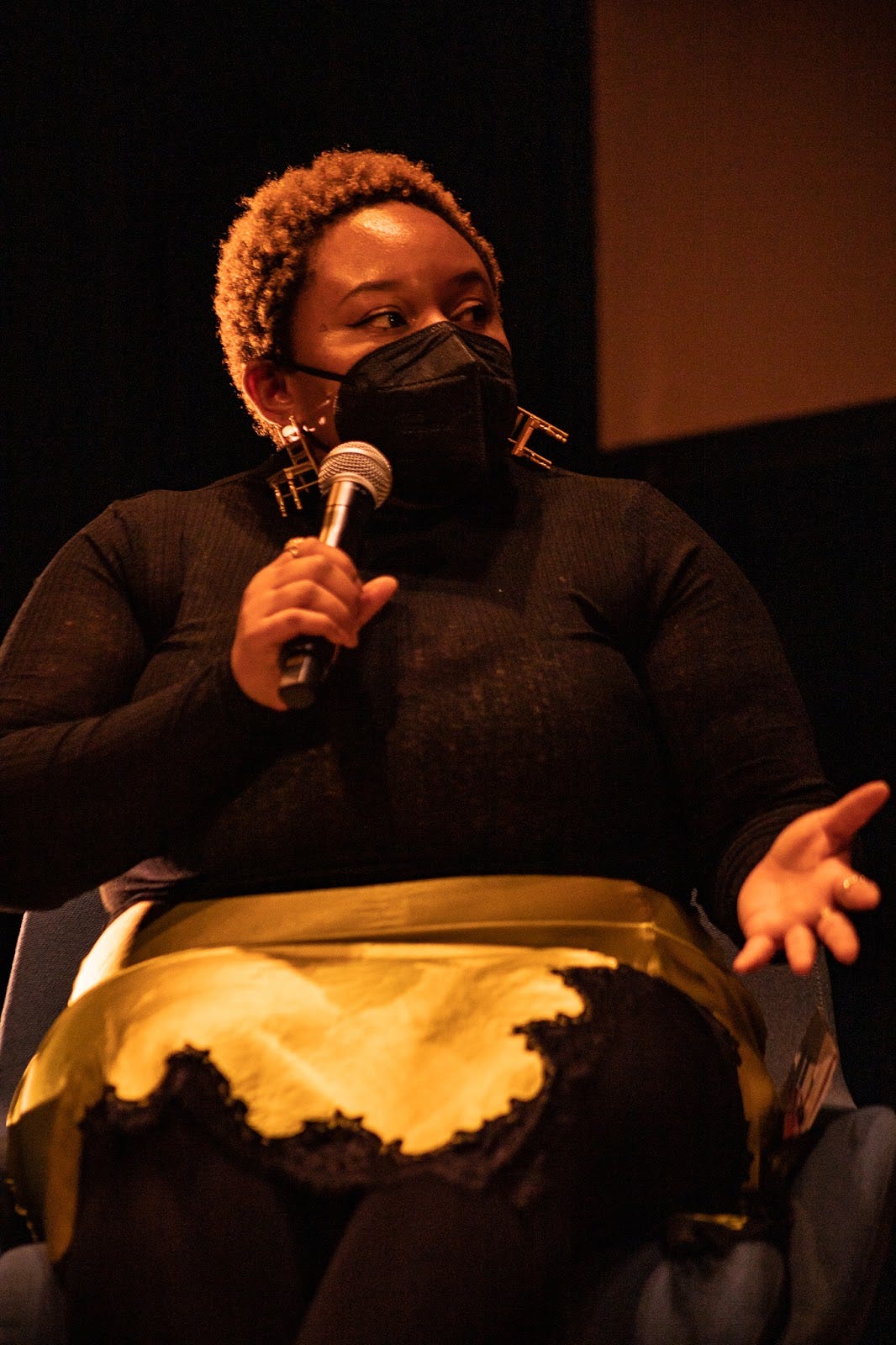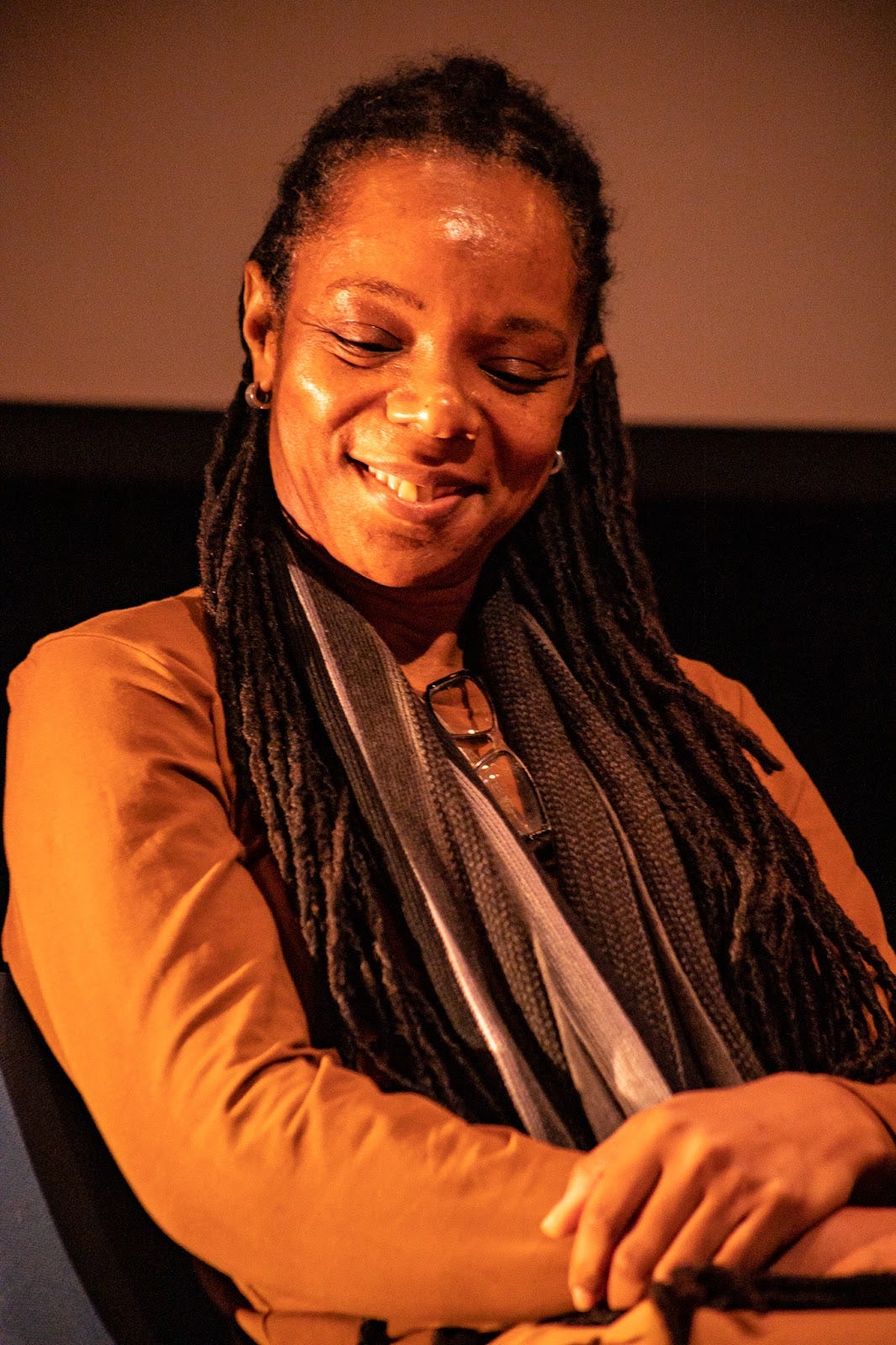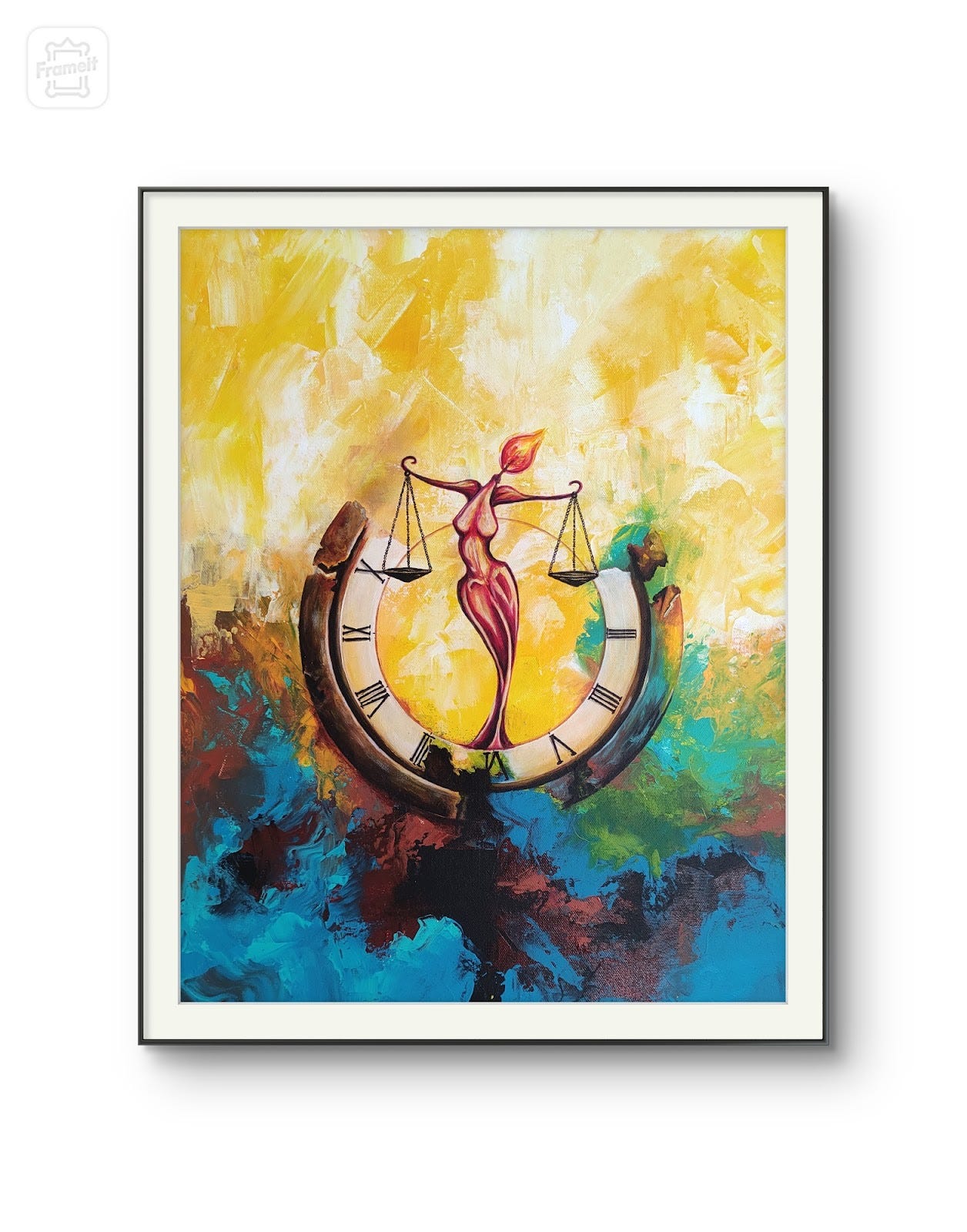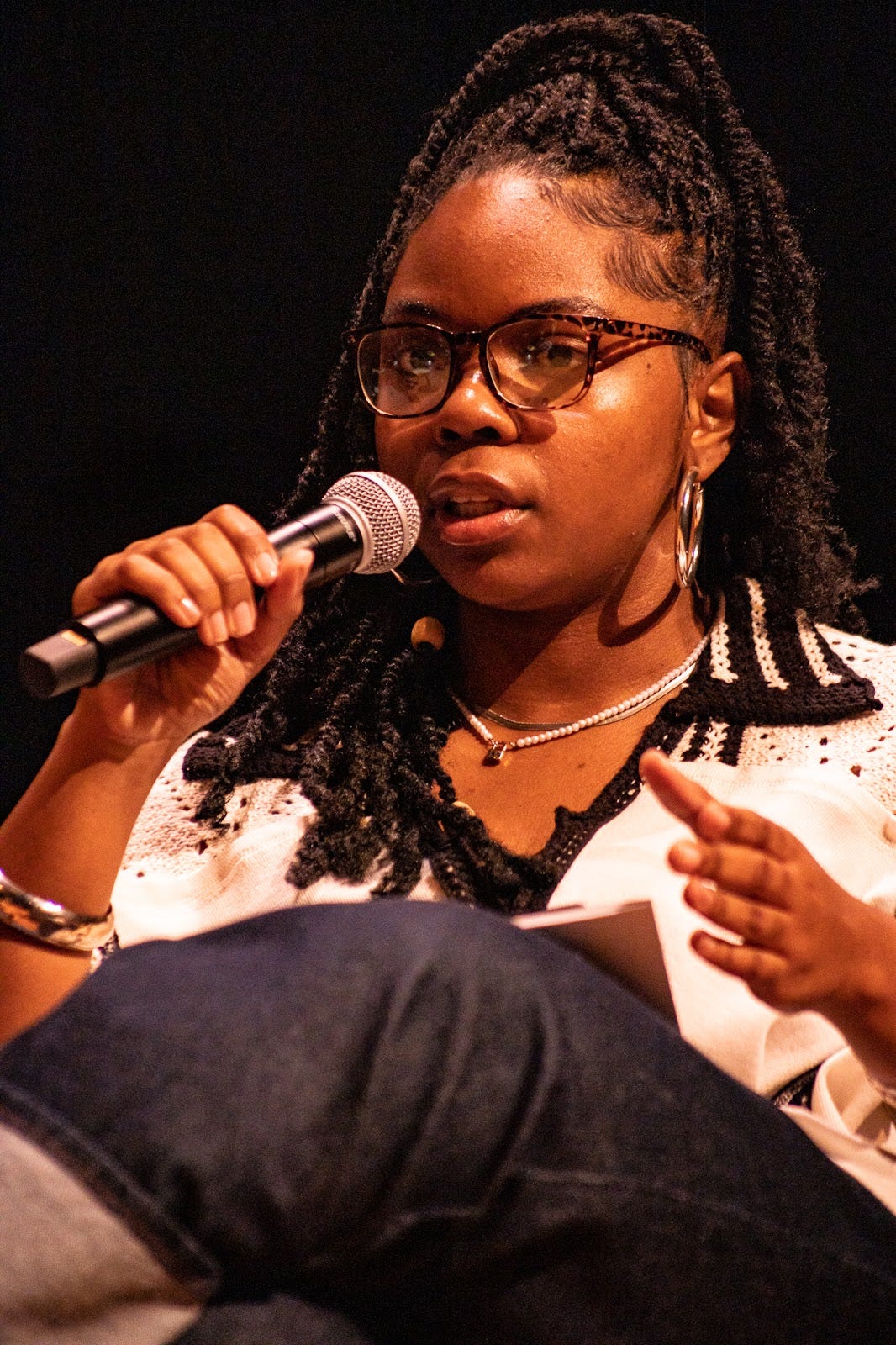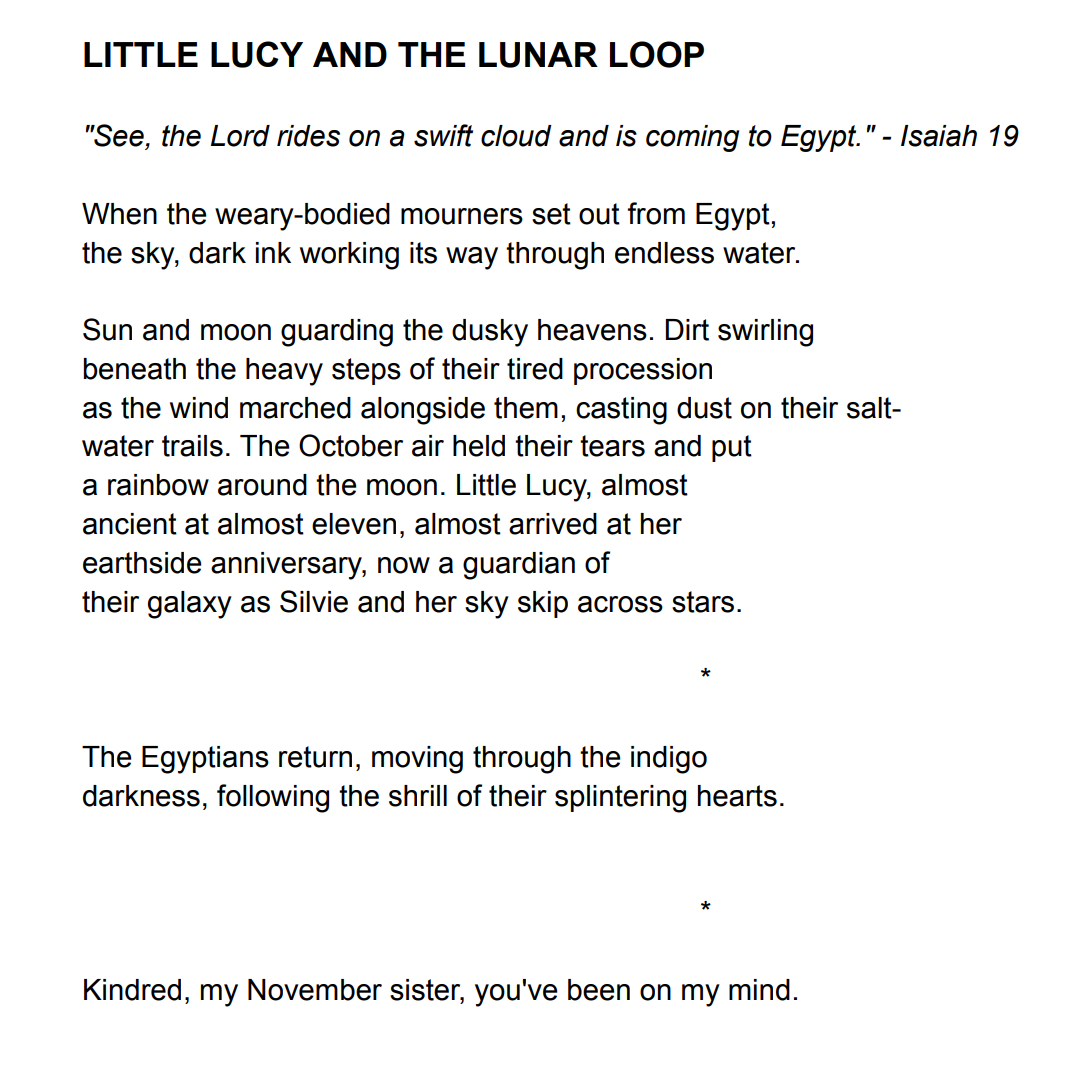Diving Deeper: Slavery in Motion Artists in Conversation
We talked more with the artists about their relationships to art, history, Molia, Silvia, and the women whom we have yet to discover in the archive of slavery.
On January 16, 2025, Remains // An Archive, a seed lab of the Diaspora Solidarities Lab, a part of the LifexCode: Digital Humanities Against Enclosure ecosystem, held a conversation at the Baltimore Museum of Art with four artists who created works to illuminate Remains’ research for its Slavery in Motion project. Dr. Brooke Mai, LifexCode Project Manager, sat down with the artists - Tatiana Esh, Julia Mallory, Romaine McNeil, and Sha-Shonna Rogers, to follow up with them after the BMA conversation and learn more about their processes and motivations. Read on for their generous and generative thoughts on the connections between art and history, the importance of mourning, and why preserving Black women’s knowledge is so critical at this moment.
You can read a recap and watch a YouTube recording of the event here.
You can learn more about Jessica Newby, the scholar on whose work Slavery in Motion is based, here.
Have you ever created a piece based on academic research before? What was new, special, or challenging about this kind of approach to art?
Julia: Yes - a lot of my work is informed by research, even if it’s not always overt. One particular project I will lift up is one of my visual art projects that is a series of photographs of capes that I created. The series called “My Cape is Hanging Somewhere in a Museum.” This project uses family genealogical research and research about Black women in labor. There was a strike of Black washerwomen in the late 1880s in Atlanta, so one cape pays tribute to my great-great grandmother who was a washerwoman, so I’m lifting up that knowledge throughout the series. One cape I made in tribute to the washerwomen has archived photos collaged onto it, as well as a testimony that one of the washerwomen gave when the establishment was trying to cut them out of getting fair rates for their labor. The women said, ‘We are more than capable of doing this work, so we should absolutely be getting the same rate of reward.’ So sometimes [my use of academic research] is overt, and sometimes it’s understated.
I have to ask - why capes?
Julia: The cape is a symbol of the superwoman myth. It came from a direct conversation I had with a friend. We were working on a community spades workshop, and I told him I wasn’t available to work on [a certain part of the project] right now. He told me, “Not all superheroes wear capes, I know you have some energy in there,” but in response I said, “My cape is hanging somewhere in a museum.” Then I was like, “Oh, I am absolutely using that in the future.”
View “My Cape is Hanging Somewhere in a Museum” here.
Romaine: I think for me, I use life research, if that makes sense, because then it becomes more of a personal experience. I tend to draw more from life, conversations, and experiences.
What was your reaction when a historian came to you to propose the idea?
Romaine: [laughs] My reaction was excitement, and more so because of the location. You get to have a different experience when you are in the space - it’s not just trees and bush and sea and sand. There’s an actual story of things happening in the space. I was nervous because I’ve never dived that deep into anything about slavery and Black lives, so it was a little intimidating at first. I fell back on my ability to feel emotions.
I was interested in this because, as an academic, this felt like such a new way to express what we find in the archive. It would be amazing to have artistic interpretations of my own research. It seems like a great way for both parties to push the boundaries of their work.
Tatiana: The artwork I create on my own is usually fictional/fantasy-based and pulled out of my own mind, but my mind is the direct result of life and learning. I’m constantly thinking about how “research” has influenced my art. Approaching this project was interesting because it was the first time I needed to make a direct draw from a specific piece of research. I went through a number of rounds of what I wanted to work on. One of them was more fantasy-oriented, I was working with a lot of blues, and there were two sisters. I leaned away from doing that because I felt I hadn’t adhered close enough to the research after talking to Jessica [Newby] about it. Jessica provided me with another piece she had written, and I was able to dig deeper and situate myself in the world she was showing us.
Boundaries can be very productive or very challenging. I have individual questions for each of you to dive deeper into the piece you created. For Romaine: I found the balance scale in your piece to be especially striking. What inspired you to include it? What does it represent for you?
Romaine: I started using the scales almost two years ago. One of the first times I used it had to do with three women having a conversation. One woman was holding the scale in her palm and was trying to show the other two what it represents. She was trying to share the knowledge and wisdom of ancestors, about finding justice for yourself and balance within yourself. One [of the other women] didn’t seem that interested in it, but the other was like, okay, this makes sense. I used it in this project because I was drawn to Molia running away after Silvia died. It’s the same feeling of trying to get justice for yourself. [She was] treated as an object, a thing, a tool, not as a person with emotions. I had her hold [the scales] because she was taking the reigns. When she ran away, that was her time to heal, find enlightenment, and restore justice for herself. It also resonates with me because I have to find balance within myself when I am working, because if I get too caught up in the work, a lot of things suffer (and vice versa). It’s important to hold balance in your life.
That resonates a lot with me. We have a lot of things in our lives that are equally important to work that we need to attend to. Are the balance scales something that recur in your work?
Romaine: Yes. I’m actually working on a piece right now with them.
For Sha-Shonna: you mentioned in the BMA conversation that dance is “spiritual.” Can you tell us more about the choice to add dance into your film?
Sha-Shonna: I remember when I was planning out the film, I was struggling trying to figure out what parts of modern-day Silvia I wanted to show. Molia’s movement kept popping out to me. Movement and motion was such a big part of Molia’s story - being taken from one location to another and running away. When I was thinking about the modern version of Silvia, dance kept popping up. I think dance naturally pops up for me a lot - I have mentors who are dancers, and I hear how they talk. And just as [a Black person], dance is a big part of who we are. I had been reading a lot about ceremonies at the same time that I was reading Jessica’s work. Dance was a big part of Caribbean and African ceremonies. I had a vision of Silvia dancing as a release and as a form of trying to connect to her mother. That’s why the dance in the film is so elongated - my intention was to have Silvia connect.
What do you mean by a “modern version of Silvia”?
Sha-Shonna: I was wondering how Silvia could or would be if she had lived past 15 months, if she had been raised. I wanted to give Molia a spiritual view of what her daughter could have been in the present.
For Julia: what was the inspiration for including opera? I know you mentioned at the BMA you had been working with sound and had an interest in working with a Black opera singer, but I wanted to hear more about why that genre appealed to you and made sense for this piece .
Julia: Me utilizing an opera singer’s work was an extension of a project that I still hope to bring to life that features the refrain, “Where are you now, little Black girl?” That refrain came to me in a dream. [In the dream] a healing ritual was happening. I was in the audience, and the folks who were initiating the ritual informed the audience they were not just there [to watch] but to be active participants. The ritual was centered on a survivor of sexual assault. We were chanting that refrain during the ritual. Part of this project I am envisioning will embody the refrain in a variety of musical genres. What felt right for this project was the way the voice stretches in opera, the way [the singer’s] voice is holding so much emotion and power. It feels like it is stretching across time. It almost defies description. The voice is embodying what words can’t necessarily hold. Even though she’s using the words that came to me in a dream, her voice is adding something additional that says this is just how tragic, difficult, and expansive this experience is. The voice is doing that in a way that words cannot.
I wanted to add that one of the lines you wrote that really hit me was, “Almost ancient at almost eleven.” It reminds me of what Sho-shanna was just talking about - imagining the life Silvia could have had, and that eleven could be “ancient.”
Julia: Yes. Sometimes when I am creating works, I can feel like I am falling inside of a ritual that feels very productive or functional, but every time I revisit the audio, it still hits me so hard. Even at the BMA event, I got tears in my eyes. There is something about Chantal’s [Braziel] voice that makes it so fresh because it’s a part that is not me. I get reintroduced to it all over again because her voice is a vessel.
For Tatiana: At the BMA, you spoke about how this was your first time not painting a portrait and instead creating a scene. Did you consider imagining a portrait for this? What inspired you to tackle this new challenge?
Tatiana: Yes, I definitely went through a number of portrait ideas. There was also a time where I was considering working digitally because I’ve been working on digital painting. To be honest, I wasn’t sure if I wanted to print it out or see it on a screen. There is something really beautiful about going to an exhibition and seeing physical work. I was happy that I was pushed towards traditional media and away from portraits. The thing that inspired that challenge was being intimidated by trying to represent the face of someone who I don’t know. I was already intimidated by trying to represent the story, period. When I closed my eyes, a face never came into focus. It was always a back, or blurred features like seeing Molia through water. Similar to Romaine, I made her back smooth and free of scars. I think with portraits, it can be dangerous sometimes to do representation and lean into ideas about beauty and general aesthetics, versus focusing on the feelings I experienced when I was engaging with this work, especially the feelings I had when I was trying to relate and slip into Molia’s shoes as best as I could. I was really pulled to the forest and nature, the overwhelming beauty, and how scary it might have been. So yes, I did consider a portrait, but I’m really happy I didn’t go with [the portrait idea]. I found that I really like painting plants!
I have to ask - is the tree in the top right of the painting supposed to be a woman? That’s all I can see!
Tatiana: [laughs] I’m curious why you see that but I love that you do. For me, the tree became larger-than-life. I was stuck on how old Molia was when she was kidnapped. It made me think about imagination and trauma. There’s an idea that you almost get frozen [at the time of trauma]. I couldn’t stop thinking about how a child would engage in the forest, especially because she was 4’6”! I was thinking about how colossal these ancient forests must have been because this was before deforestation. The tree did take on new life, and the forest became a massive thing. The tree did come alive in my head. I personally think art is about channeling. The role of the artist is to tap into something deeper, and when you finish and give that art out, it becomes something a lot bigger than any one person can decide.
I have a few questions for the group again. This was touched on at the BMA, but I wanted to revisit it and hear more. Tatiana, you said, “I felt like I had developed an intimate relationship with Molia and Silvia.” That really spoke to me as an academic because I feel like I have relationships with the women I write about. Can you each tell us about your relationship with the women in Jessica Newby’s research? Has something deepened or shifted for you as you’ve had the opportunity to talk about this, and, honestly, if this political moment has shifted anything for you?
Romaine: I think that the intimacy grew with myself. I can see what she went through, what other women through, and what I go through. You know how you go to work and you have two weeks off the entire year to compensate for however many months of labor? Molia wasn’t about the two-week life - she took the break when she wanted it. That resonated a lot with me - I’ve only ever had one 9-to-5, and it lasted three days [laughter]. I was always more focused on my peace of mind than making money. She became focused more on her peace of mind than on labor or being slashed or chained. For you to be able to have that mental power is amazing because you’ve made up your mind that, “I’m going to be punished for this, but I’m going to enjoy this free time. I’m going to bond with other slaves, I’m going to enjoy this free time.” She was quite young. She was still in her learning phase and coming into her own. For me, that says a lot about how we are in life: if you’re stagnant and stuck, then you don’t grow. She was ready to claim her own.
Amen. We have a work problem in this country! [laughs]
Romaine: In other countries, you can have a four-day work week. I work seven days a week, but whenever I want. I can imagine in the fields, in the hot sun, you’re not being fed properly, and you still have to produce and show up - and she was just not about that life. She was like, I’m going to go to the sea, to the forest, bond with the trees, I’m going to go to the river and catch some fish. We still have sort of a slave mentality in the modern day. You’re not getting whooped and slashed, but it’s very much present.
Sha-Shonna: Something that deepened was - I kind of talked about it at the BMA - once the project was done, especially after the BMA, I was sitting with myself, kinda wondering about honoring Molia and Silvia and Jessica’s research throughout the process, and I remember that taking such a toll on my process and my mental [health]. I guess my relationship with myself and creating [changed]. I learned when I’m honoring someone and I want to bring a true story into the present, not to spend so much time in my head. I almost felt like “cheating” the research a bit - I don’t know if that’s the correct term, I can’t think of another way to phrase it - but I felt like because I had spent so much time overthinking a lot of things and thinking about how the work would be taken in by people and how would the work be viewed, some moments I wish I had spent more time going as deep that I could possibly go in the work to do my honoring. Not to say I don’t feel like I went deep, but I think that time and emotion I spent overthinking could have been placed in something else. My relationship with myself and my creative ability deepened in that way. I became a bit more aware that’s something I struggle with at the end of the process. I remember at the end of the panel, when Dr. Johnson came up and [gave] the closing statement, and she was like, “Molia, did you think no one would mourn you?” - I remember getting chills and feeling like a lot of things set in. Here you have a group of researchers and artists, all of us here to create Molia’s story and bring it to people because a lot of people don’t know her story. Also just being like, “Damn, this woman probably did think no one would mourn her or revisit her story. Also thinking about the many other women who we have yet to discover in the archives or research, and also in the present time, we have a lot of women - we just struggle with not being seen or not being heard.”
Yeah. The reason I like doing history is because I feel like I can make people who were ignored in their own time be seen and heard and finally validated. I appreciate how your work does that for Molia and Silivia.
Tatiana: When Dr. Johnson closed us out like that and said, “She inoculated us with resistance,” that’s kind of what everyone just said - it shows why history is important. It can be frustrating - in today’s political climate, whatever is happening, people are shutting down instead of using it as a means to go further. I’m also vulnerable to that - there’s extreme exhaustion, the constant negativity, the news cycle. But turning to Molia and Silvia and other people in the past, and seeing not only how they have done it, but have survived worse things than I have gone through. They didn’t just survive, but were resisting and fighting. It’s really inspiring. I’m honestly just grateful for this whole project because, again, it makes me want to think about intentional research moving forward.
That was a perfect note to end on, I’m wondering if I should keep going! I’ll pose the last two questions [I prepared] and if you feel moved to answer or chime in on what Tatiana said, feel free to. Julia, you mentioned at the BMA that you are very interested in Black women’s survival. What does Black women’s survival mean to each of you? Building on that, how does your artwork speak to freedom, both generally and specifically Black women’s freedom? And during the event, Samantha asked about the concept of motion, including how the project moved you emotionally. I want to hone in on how working on this project moved you emotionally?
Romaine: I think women will carry - how should I put this? Women are carriers of life, and therefore are carriers of infinite information. To not have that possible, a lot is gonna be lost. It’s sad to even think about the information that has already been lost. There’s an African saying - I’m gonna summarize it - that says, “To lose an elder is to lose a library.” Here in Jamaica, there are a lot of grandparents who would love to pass knowledge on, but for some strange reason the younger generation isn’t interested in learning. For them, that means survival or continuation of a lot of things, just Black lives in general. I think Tatiana said it - “To know your history is to know your future.” Everything repeats itself. There is nothing new under the sun. Everything is is just being repeated in a different era. If we can focus on preserving what knowledge and wisdom is there, then we can ensure more continuation of life in general.
Julia: I’ll add a little bit around the question of Black women’s survival. I don’t think across space and time it has really changed, but, if I’m answering this question right now, I think Black women’s survival is directly tied to our ability to have full autonomy over who we are. In referencing Molia, and other Black women or Black people who have functioned essentially as Dr. Joy James calls “captive maternals,” I think there is something about having bodily autonomy, about reproduction, about the service of the labor that you provide and who you provide it for. And being able to even - I mentioned my capes series, and labor and fair compensation being directly tied to that. I think for me Black women’s survival is directly tied to Black women’s ability to practice refusal. I feel like that’s a good place to put a period.
Julia Mallory
This interview was conducted and edited for space and clarity by Dr. Brooke Mai.
Photographs: Christina Arias-Randolph




